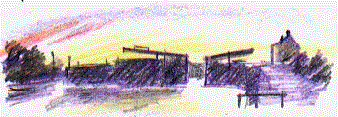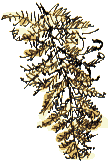 |
A Song of SummerFriday, 21st June 2002, West Yorkshire |
![]()
![]()
![]()
![]() Rocks |
History |
Workshop |
Links |
Home Page
Rocks |
History |
Workshop |
Links |
Home Page
![]()
 It's hard to believe that it's midsummer's day already. This morning it's as quiet here as it is at Christmas, around the time of the winter solstice. This isn't because of any special solstice holiday; the country has come to a standstill because an estimated 30 million of us, about half the population, are watching England play Brazil. The recorded highlights will do fine for me.
It's hard to believe that it's midsummer's day already. This morning it's as quiet here as it is at Christmas, around the time of the winter solstice. This isn't because of any special solstice holiday; the country has come to a standstill because an estimated 30 million of us, about half the population, are watching England play Brazil. The recorded highlights will do fine for me. The longest day of the year gives us the opportunity to take a late evening walk along the towpath. Just below the Figure of Three locks there's a bank which just a month or two ago was burnt back to the sandy soil. It's now completely covered with bracken which is already three feet high.
The longest day of the year gives us the opportunity to take a late evening walk along the towpath. Just below the Figure of Three locks there's a bank which just a month or two ago was burnt back to the sandy soil. It's now completely covered with bracken which is already three feet high. On such a still evening scents hang in the air; as we walk past one stretch of the hawthorn hedge Barbara exclaims 'Rodents!'
On such a still evening scents hang in the air; as we walk past one stretch of the hawthorn hedge Barbara exclaims 'Rodents!'The mousy smell comes from a clump of hemlock, an umbellifer with smooth purple-blotched stems. Most umbellifers are pollinated by flies so their flowers employ the kinds of scents that flies find attractive.
Ode to a Nightingale
My dictionary of quotations gives only one reference to hemlock. It comes at the start of John Keats' bittersweet Ode to a Nightingale, published in 1820 but probably written in the previous May;'My heart aches, and a drowsy numbness painsAccording to a friend, Keats wrote the poem on scraps of paper while sitting beneath a plum tree in a garden in Hampstead. Heartache and drowsy numbness are hardly the reactions you'd expect to the song of a nightingale but the previous year his brother had died from tuberculosis and Keats himself was already showing the symptoms. He'd met and fallen in love with Fanny Brawne the previous winter but they were never able to marry.
My sense, as though of hemlock I had drunk,'
 I like his descriptions of 'verdurous glooms and windless mossy ways' and of musk rose as 'the murmurous haunt of flies on summer eves'.
I like his descriptions of 'verdurous glooms and windless mossy ways' and of musk rose as 'the murmurous haunt of flies on summer eves'.Considering his state of mind it's hardly surprising that Keats equates the song and drowsy summer evenings with oblivion, forgetfulness and the mysteries of poetic inspiration, as if the song was an intoxicating draught of a narcotic brew. Anyway, read the full poem and decide for yourself;
During the Victorian period when a nightingale sang in Coxley Valley to the south west of Wakefield people came from miles away to hear it. In 1875 a nightingale was shot by a collier in Haw Park south east of Wakefield. He thought it would have spectacular plumage to match its song.
I've only ever heard nightingales in Greece and in the former Yugoslavia.
![]()
Richard Bell,
wildlife illustrator
E-mail; 'richard@willowisland.co.uk'
![]() Next page |
Previous page |
This day in 2000 |
This month |
Nature Diary |
Home Page
Next page |
Previous page |
This day in 2000 |
This month |
Nature Diary |
Home Page
![]()